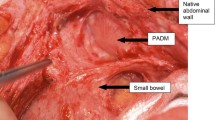Abstract
Background
Elective or emergency reconstruction of abdominal wall defects (AWD) is often difficult. Various techniques have been proposed for reconstructing AWD, including the use of synthetic implants. Porcine acellular dermal collagen (PermacolTM) is a biologic implant (PADCI) derived from porcine dermis. We report our experience with the use of PADCI in the management of large AWD in both emergency and elective surgery.
Methods
Twenty consecutive patients with chronic AWD (CAWD) arising from large incisional hernia or acute AWD (AAWD) arising from visceral edema or tumor resection were studied prospectively. After musculofascial mobilization, the AWD was closed using sheets (10 × 15 cm) of PADCI as an “underlay” interposition graft. Patients were followed up to a median of 18 months postoperatively.
Results
All 20 defects were closed without tension using PADCI. Eight and 12 patients had reconstruction for large AAWD and CAWD, respectively. The mean size of the defects was 180 cm2 (range = 96–850 cm2). The median number of PADCI used to repair the defects was one sheet (range = 1–7). Twelve patients (60%) had an uneventful recovery and were discharged within seven days. One patient (5%) died from multiple-organ failure. Seven patients (35%) developed a complication (two seromas, two minor wound infections, one wound hematoma, one skin edge necrosis, one superficial wound dehiscence, and wound sinus). Overall there were three recurrences (15%).
Conclusion
PADCI has the potential for reconstruction of large acute and chronic abdominal wall defects. Medium-term recurrence rate is comparable to synthetic mesh repairs.
Similar content being viewed by others
References
Mudge M, Hughes LE (1985) Incisional hernia: a 10 year prospective study of incidence and attitudes. Br J Surg 72:70–71
Ramirez OM, Ruas E, Dellon AL (1990) “Components separation” method for closure of abdominal-wall defects: an anatomic and clinical study. Plast Reconstr Surg 86: 519–526
Bauer JJ, Harris MT, Kreel I, et al. (1999) Twelve-year experience with expanded polytetrafluoroethylene in the repair of abdominal wall defects. Mt Sinai J Med 66:20–25
Luijendijk RW, Hop WC, van den Tol MP, et al. (2000) A comparison of suture repair with mesh repair for incisional hernia. N Engl J Med 343:392–398
Caffee HH (1983) Reconstruction of the abdominal wall by variations of the tensor fasciae latae flap. Plast Reconstr Surg 71:348–353
Harper C (2001) Permacol: clinical experience with a new biomaterial. Hosp Med 62:90–95
Giri SK, Drumm J, Saunders JA, et al. (2005) Day-case sling surgery for stress urinary incontinence: feasibility and safety. BJU Int 95:827–832
Saray A (2003) Porcine dermal collagen (Permacol) for facial contour augmentation: preliminary report. Aesthetic Plast Surg 27:368–375
Brock WB, Barker DE, Burns RP (1995) Temporary closure of open abdominal wounds: the vacuum pack. Am Surg 61:30–35
George CD, Ellis H (1986) The results of incisional hernia repair: a twelve year review. Ann R Coll Surg Engl 68:185–187
Paul A, Korenkov M, Peters S, et al. (1998) Unacceptable results of the Mayo procedure for repair of abdominal incisional hernias. Eur J Surg 164:361–367
Voyles CR, Richardson JD, Bland KI, et al. (1981) Emergency abdominal wall reconstruction with polypropylene mesh: short-term benefits versus long-term complications. Ann Surg 94:219–223
Butler CE, Prieto VG (2004) Reduction of adhesions with composite AlloDerm/polypropylene mesh implants for abdominal wall reconstruction. Plast Reconstr Surg 114:464–473
Bleichrodt RP, Simmermacher RK, van der Lei B, et al. (1993) Expanded polytetrafluoroethylene patch versus polypropylene mesh for the repair of contaminated defects of the abdominal wall. Surg Gynecol Obstet 176:18–24
Brown GL, Richardson JD, Malangoni MA, et al. (1985) Comparison of prosthetic materials for abdominal wall reconstruction in the presence of contamination and infection. Ann Surg 201:705–711
Hodde J (2002) Naturally occurring scaffolds for soft tissue repair and regeneration. Tissue Eng 8:295–308
Disa JJ, Goldberg NH, Carlton JM, et al. (1998) Restoring abdominal wall integrity in contaminated tissue-deficient wounds using autologous fascia grafts. Plast Reconstr Surg 101:979–986
Lowe JB 3rd, Lowe JB, Baty JD, et al. (2003) Risks associated with “components separation” for closure of complex abdominal wall defects. Plast Reconstr Surg 111:1276–1283
de Vries Reilingh TS, van Goor H, Rosman C, et al. (2003) “Components separation technique” for the repair of large abdominal wall hernias. J Am Coll Surg 196:32–37
Zheng F, Lin Y, Verbeken E, et al. (2004) Host response after reconstruction of abdominal wall defects with porcine dermal collagen in a rat model. Am J Obstet Gynecol 191:1961–1970
Leber GE, Garb JL, Alexander AI, et al. (1998) Long-term complications associated with prosthetic repair of incisional hernias. Arch Surg 133:378–382
Sarmah BD, Holl-Allen RT (1984) Porcine dermal collagen repair of incisional herniae. Br J Surg 1:524–525
Liyanage SH, Purohit GS, Frye JN, et al. (2005) Anterior abdominal wall reconstruction with a Permacol implant. J Plast Reconstr Aesthet Surg 59:553–555
Martin-Duce A, Noguerales F, Villeta R, et al. (2001) Modifications to Rives technique for midline incisional hernia repair. Hernia 5:70–72
de Vries Reilingh TS, van Geldere D, Langenhorst B, et al. (2004) Repair of large midline incisional hernias with polypropylene mesh: comparison of three operative techniques. Hernia 8:56–59
Gupta A, Zahriya K, Mullens PL, et al. (2006) Ventral herniorrhaphy: experience with two different biosynthetic mesh materials, Surgisis and Alloderm. Hernia 10:419–425
Israelsson LA, Jonsson L, Wimo A (2003) Cost analysis of incisional hernia repair by suture or mesh. Hernia 7:114–117
Author information
Authors and Affiliations
Corresponding author
Rights and permissions
About this article
Cite this article
Shaikh, F.M., Giri, S.K., Durrani, S. et al. Experience with Porcine Acellular Dermal Collagen Implant in One-stage Tension-free Reconstruction of Acute and Chronic Abdominal Wall Defects. World J Surg 31, 1966–1972 (2007). https://doi.org/10.1007/s00268-007-9174-4
Published:
Issue Date:
DOI: https://doi.org/10.1007/s00268-007-9174-4




